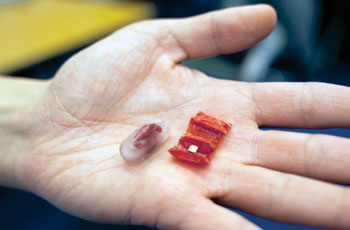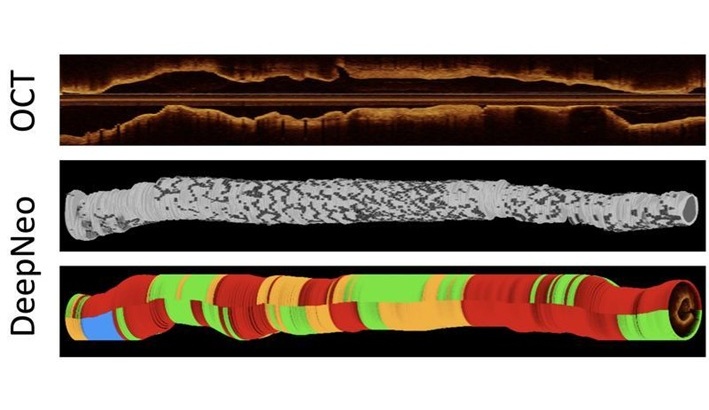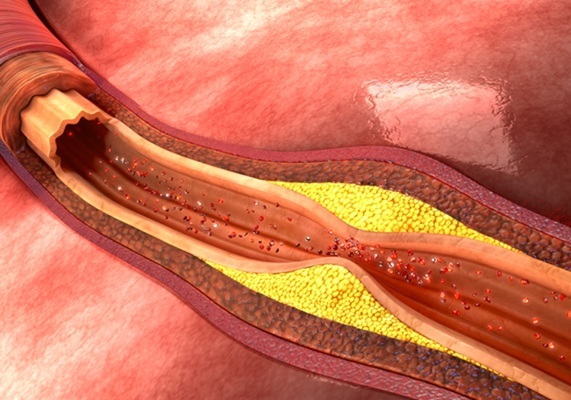Unfolding Origami Robot Helps Retrieves Ingested Artifacts
|
By HospiMedica International staff writers Posted on 26 May 2016 |

Image: The ingestible capsule and the unfolded origami robot (Photo courtesy of Melanie Gonick / MIT).
A new study describes how a tiny origami robot steered by external magnetic fields crawled across the stomach wall to remove a swallowed button battery.
Developed by researchers at the Massachusetts Institute of Technology (MIT, Cambridge, MA, USA), the University of Sheffield (United Kingdom), and the Tokyo Institute of Technology (Japan), origami is a functional three-dimensional (3D) robot than can be actuated on-demand for untethered walking and swimming. The rectangular robot has accordion folds perpendicular to its long axis, and pinched corners that act as points of traction.
Structurally, it consists of a heat-sensitive layer sandwiched between two structural layers that form a sheet 1.7 cm3 in size. A pattern of slits in the outer layers determines how the robot will unfold when the middle layer is thermally activated. At the center of one the forward accordion folds is a permanent cubic neodymium magnet that responds to changing magnetic fields outside the body. The forces that control the robot’s motion are principally rotational; a quick rotation will make it spin in place, but a slower rotation will cause it to pivot around one of its fixed feet.
Since the robot has asymmetric body balance along the sagittal axis, it can walk at a speed of 3.8 body-lengths per second while under control of the alternating external magnetic field. The origami robot propels itself using a “stick-slip” motion, in which its appendages stick to a surface through friction when it executes a move, but slip free again when its body flexes to change its weight distribution. The robot is made of a biocompatible, acetone-degradable material that allows the entire robot’s body to vanish in a liquid.
In experiments involving a simulation of the human esophagus and stomach, the robot unfolded itself from an ingestible capsule, and steered by external magnetic fields, crawled across the simulated stomach wall to remove a swallowed button using its cubic neodymium magnet. It then degraded. The origami robot was presented at the International Conference on Robotics and Automation, held during May 2016 in Stockholm (Sweden).
“It’s really exciting to see our small origami robots doing something with potential important applications to health care,” said study presenter Professor Daniela Rus, PhD, director of the MIT Computer Science and Artificial Intelligence Laboratory (CSAIL). “For applications inside the body, we need a small, controllable, untethered robot system. It’s really difficult to control and place a robot inside the body if the robot is attached to a tether.”
Related Links:
Massachusetts Institute of Technology
University of Sheffield
Tokyo Institute of Technology
Developed by researchers at the Massachusetts Institute of Technology (MIT, Cambridge, MA, USA), the University of Sheffield (United Kingdom), and the Tokyo Institute of Technology (Japan), origami is a functional three-dimensional (3D) robot than can be actuated on-demand for untethered walking and swimming. The rectangular robot has accordion folds perpendicular to its long axis, and pinched corners that act as points of traction.
Structurally, it consists of a heat-sensitive layer sandwiched between two structural layers that form a sheet 1.7 cm3 in size. A pattern of slits in the outer layers determines how the robot will unfold when the middle layer is thermally activated. At the center of one the forward accordion folds is a permanent cubic neodymium magnet that responds to changing magnetic fields outside the body. The forces that control the robot’s motion are principally rotational; a quick rotation will make it spin in place, but a slower rotation will cause it to pivot around one of its fixed feet.
Since the robot has asymmetric body balance along the sagittal axis, it can walk at a speed of 3.8 body-lengths per second while under control of the alternating external magnetic field. The origami robot propels itself using a “stick-slip” motion, in which its appendages stick to a surface through friction when it executes a move, but slip free again when its body flexes to change its weight distribution. The robot is made of a biocompatible, acetone-degradable material that allows the entire robot’s body to vanish in a liquid.
In experiments involving a simulation of the human esophagus and stomach, the robot unfolded itself from an ingestible capsule, and steered by external magnetic fields, crawled across the simulated stomach wall to remove a swallowed button using its cubic neodymium magnet. It then degraded. The origami robot was presented at the International Conference on Robotics and Automation, held during May 2016 in Stockholm (Sweden).
“It’s really exciting to see our small origami robots doing something with potential important applications to health care,” said study presenter Professor Daniela Rus, PhD, director of the MIT Computer Science and Artificial Intelligence Laboratory (CSAIL). “For applications inside the body, we need a small, controllable, untethered robot system. It’s really difficult to control and place a robot inside the body if the robot is attached to a tether.”
Related Links:
Massachusetts Institute of Technology
University of Sheffield
Tokyo Institute of Technology
Latest Surgical Techniques News
- DNA Origami Improves Imaging of Dense Pancreatic Tissue for Cancer Detection and Treatment
- Pioneering Sutureless Coronary Bypass Technology to Eliminate Open-Chest Procedures
- Intravascular Imaging for Guiding Stent Implantation Ensures Safer Stenting Procedures
- World's First AI Surgical Guidance Platform Allows Surgeons to Measure Success in Real-Time
- AI-Generated Synthetic Scarred Hearts Aid Atrial Fibrillation Treatment
- New Class of Bioadhesives to Connect Human Tissues to Long-Term Medical Implants
- New Transcatheter Valve Found Safe and Effective for Treating Aortic Regurgitation
- Minimally Invasive Valve Repair Reduces Hospitalizations in Severe Tricuspid Regurgitation Patients
- Tiny Robotic Tools Powered by Magnetic Fields to Enable Minimally Invasive Brain Surgery
- Magnetic Tweezers Make Robotic Surgery Safer and More Precise
- AI-Powered Surgical Planning Tool Improves Pre-Op Planning
- Novel Sensing System Restores Missing Sense of Touch in Minimally Invasive Surgery
- Headset-Based AR Navigation System Improves EVD Placement
- Higher Electrode Density Improves Epilepsy Surgery by Pinpointing Where Seizures Begin
- Open-Source Tool Optimizes Placement of Visual Brain Implants
- Easy-To-Apply Gel Could Prevent Formation of Post-Surgical Abdominal Adhesions
Channels
Critical Care
view channel
AI Model Analyzes Patient Data to Diagnose Multiple Sclerosis With 90% Accuracy
Multiple sclerosis (MS) is a chronic inflammatory condition affecting the central nervous system. Most patients initially experience the relapsing-remitting form (RRMS), characterized by periods of symptom... Read more
Magnetically Navigable Microparticles Enable Targeted Drug Delivery
Abdominal aortic aneurysms (AAA) can be life-threatening if not treated and result in nearly 10,000 deaths annually. Researchers working to improve treatments for AAA could now make it possible for doctors... Read more
AI-Powered Algorithm Automates Analysis of Coronary Stents After Implantation
Every year, over three million people globally receive stents to open blocked blood vessels caused by heart disease. However, monitoring the healing process after stent implantation remains a significant challenge.... Read morePatient Care
view channel
Portable Biosensor Platform to Reduce Hospital-Acquired Infections
Approximately 4 million patients in the European Union acquire healthcare-associated infections (HAIs) or nosocomial infections each year, with around 37,000 deaths directly resulting from these infections,... Read moreFirst-Of-Its-Kind Portable Germicidal Light Technology Disinfects High-Touch Clinical Surfaces in Seconds
Reducing healthcare-acquired infections (HAIs) remains a pressing issue within global healthcare systems. In the United States alone, 1.7 million patients contract HAIs annually, leading to approximately... Read more
Surgical Capacity Optimization Solution Helps Hospitals Boost OR Utilization
An innovative solution has the capability to transform surgical capacity utilization by targeting the root cause of surgical block time inefficiencies. Fujitsu Limited’s (Tokyo, Japan) Surgical Capacity... Read more
Game-Changing Innovation in Surgical Instrument Sterilization Significantly Improves OR Throughput
A groundbreaking innovation enables hospitals to significantly improve instrument processing time and throughput in operating rooms (ORs) and sterile processing departments. Turbett Surgical, Inc.... Read moreHealth IT
view channel
Printable Molecule-Selective Nanoparticles Enable Mass Production of Wearable Biosensors
The future of medicine is likely to focus on the personalization of healthcare—understanding exactly what an individual requires and delivering the appropriate combination of nutrients, metabolites, and... Read more
Smartwatches Could Detect Congestive Heart Failure
Diagnosing congestive heart failure (CHF) typically requires expensive and time-consuming imaging techniques like echocardiography, also known as cardiac ultrasound. Previously, detecting CHF by analyzing... Read moreBusiness
view channel
Expanded Collaboration to Transform OR Technology Through AI and Automation
The expansion of an existing collaboration between three leading companies aims to develop artificial intelligence (AI)-driven solutions for smart operating rooms with sophisticated monitoring and automation.... Read more
















